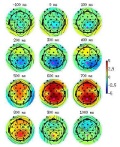 3D – Ever since the advent of 3D technologies, researchers have been investigating the psychological and physiological effects on users of viewing stereoscopic imagery.
3D – Ever since the advent of 3D technologies, researchers have been investigating the psychological and physiological effects on users of viewing stereoscopic imagery.
The general impression that I have obtained from reading many such studies is that the most common test protocol consists of showing the user a series of stereoscopic images and receiving either an anecdotal report on the experience or measuring the performance of the user on selected tasks. This week I became aware of research into so-called stereo comfort that is based on an approach that extends this protocol in quite an interesting way. It is based on using an electroencephalograph (EEG) to directly measure the user’s brain functionality during the use of a 3D system and correlating these measurements to the user’s experience.
The first article I encountered was entitled “Assessment visual fatigue of watching 3DTV using EEG power spectral parameters”. The research was conducted at the Nanjing University of Aeronautics & Astronautics (Nanjing, China). It was published in Displays, Volume 35, Issue 5, December 2014, Pages 266–272. The article is also available for purchase here.
With a little online search, I soon found a second article on the same subject. It was entitled “Assessing the Zone of Comfort in Stereoscopic Displays using EEG”. The research was conducted at the Université de Bordeaux (Bordeaux, France). It was published in CHI ‘14 Extended Abstracts on Human Factors in Computing Systems, Apr 2014, Toronto, Canada. ACM, pp.2041-2046, CHI EA ‘14. The article is available online and can be found here.
I found that a great deal of the terminology in these articles was unfamiliar. Nonetheless, it is still possible to understand the principle conclusions of the articles.
As explained in the first article: “EEG has been widely used for monitoring the brain’s functional activities. Based on our previous research of 3DTV fatigue, one more objective and effective 3DTV fatigue evaluation model is proposed on gravity frequency of power spectrum and power spectral entropy. As the fatigue changes, the gravity frequency reflects the transition of EEG power spectrum and the power spectral entropy describes the level of chaos of EEG. 16 channels of EEG data of 25 subjects watching 2DTV and 3DTV were collected, and gravity frequency of power spectrum and power spectral entropy were then calculated and analyzed. These two parameters of the 3D group changed more significantly compared with that of the 2D group on several electrodes. There are significant decreases in gravity frequency and power spectral entropy in several brain regions after a long time of watching 3DTV, which indicates the decline of subjects’ alertness level. Based on the subjective evaluation and two significant parameters, gravity frequency and power spectral entropy, an accurate evaluation model for 3DTV fatigue was established using the regression equation”.
The conclusion of the second article reads slightly differently but, perhaps, is even more to the point. “Analyses showed significant differences both in event-related potentials (ERP) and in frequency bands power. An uncomfortable stereoscopy correlates with a weaker negative component and a delayed positive component in ERP. It also induces a power decrease in the alpha band and increases in theta and beta bands. With fast responses to stimuli, EEG is likely to enable the conception of adaptive systems, which could tune the stereoscopic experience according to each viewer”.
The article includes “maps” of the scalp potentials measured while viewing stereoscopic imagery. This data forms the information upon which conclusions are drawn.
The bottom line from these studies is that it should be possible to develop a means to actually make physical measurements that correlate to the user’s degree of stereo comfort. It follows that, with this feedback, it should be able to design stereoscopic display systems with improved user stereo comfort. – Arthur Berman
Nanjing University, Chunxiao Chen, +86 025 84891938, [email protected]
Université de Bordeaux, Jérémy Frey


